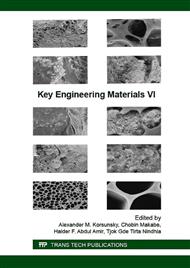[1]
Cleary P W, Ha J, Prakash M, et al. 3D SPH flow predictions and validation for high pressure die casting of automotive components[J]. Apply Math Model, 2006, 30(11): 1406-1427.
DOI: 10.1016/j.apm.2006.03.012
Google Scholar
[2]
Park Y J, Lim D H. UV and thermal- curing behaviors of dual-curable adhesives based on epoxy acrylate oligomers[J]. International Journal of Adhension & Adhesives, 2009, 29: 710~717.
DOI: 10.1016/j.ijadhadh.2009.02.001
Google Scholar
[3]
B. Ozcelik, I. Sonat. Warpage and structural analysis of thin shell plastic in the plastic injection molding[J]. Mater Des, 2009, (30): 367~375.
DOI: 10.1016/j.matdes.2008.04.053
Google Scholar
[4]
Y.K. Shen, J.J. Liu, C.T. Hartnett and C.Y. Chiu. Comparison of The Results For Semisolid And Plastic Injection Molding process[J]. Heat Mass Transfer, 2002, 29(1): 97~105.
DOI: 10.1016/s0735-1933(01)00328-1
Google Scholar
[5]
F.T. S Chan, H.C. W Lau, B Jiang. In-line Process Conditions Monitoring Expert System for Injection Molding[J]. Journal of Materials Processing Technology, 2000, 101(1): 268~274.
DOI: 10.1016/s0924-0136(00)00435-0
Google Scholar
[6]
Zhuangya Zhang, Haiguang Zhang, Yuanyuan Liu, Qingxi Hu. Abaqus-based numerical computation and experiment research on silicon rubber mould's deformation during dpvc process[J]. Key Engineering Materials, 2013, (579): 584~589.
DOI: 10.4028/www.scientific.net/kem.579-580.584
Google Scholar
[7]
Voth G.A., saint T.C., Dobler G., et al. Mixing rates and symmetry breaking in two-dimensional chaotic Flow[J]. Physics of Fluid, 2003, 15(9): 2560~2566.
DOI: 10.1063/1.1596915
Google Scholar
[8]
Wang C R, Zhou C L, Ma J W. An Improved Artificial Fish-swarm Algorithm and its Application in Feed-forward Neural Networks. Proceedings of the Fourth International Conference on Machine Learning and Cybernetics . (2005).
DOI: 10.1109/icmlc.2005.1527436
Google Scholar
[9]
K. Shelsh-Nezhad, E. Siores. An Intelligent System for Plastic Injection Molding Process Design[J]. Journal of Materials Processing Technology, 1997, 63: 458~462.
DOI: 10.1016/s0924-0136(96)02664-7
Google Scholar
[10]
K wong C K, Smith G F, Lau W S. Application of Case Based Reasoning in Injection Molding[J]. Journal of Materials Processing Technology, 1997, 63: 463~467.
DOI: 10.1016/s0924-0136(96)02665-9
Google Scholar
[11]
G.A. Vagelatos, G.G. Rigatos, S.G. Tzafestas. In Cremental Fuzzy Supervisory Controller Design for Optimizing the Injection Molding Process[J]. Expert Systems with Applications, 20 (2001): 207~216.
DOI: 10.1016/s0957-4174(00)00060-9
Google Scholar
[12]
Ya-Jung Lee, Member Cheng-Hsien and Chung Yu-Ti Jhan. Mold-flow Analysis for Manufacturing FRP Structures in Vacuum Assisted Resin Transfer Molding[J]. Conference Proceedings. Japan Society of Naval Architects and Ocean Engineers, 2006, 31(2): 35~40.
Google Scholar
[13]
Petrovic Z S, Javni I, Waddon A, et al. Structure and Properties of Polyurethane-silica Nanocomposites[J]. Appl Polym Sci, 2000, (76): 133~140.
DOI: 10.1002/(sici)1097-4628(20000411)76:2<133::aid-app3>3.0.co;2-k
Google Scholar


